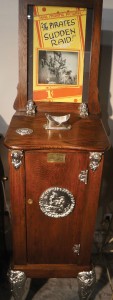DeFord met his future curator through a 1974 ad in the Dallas Times Herald. Wilkins was offering an Edison phonograph to help his parents pay his tuition at the University of Texas at Arlington.
Wilkins soon started buying collections of cylinder phonographs. He recalled selling a box of them to DeFord.
“I learned pretty quickly,” Wilkins said, “that if you want to get the cheapest price and best selection, you have to collect things where they were made, the point of origin, where they were manufactured, no matter what it is.”

Along with collectors in New York, he began corresponding with ones in West Orange, Teaneck, New Brunswick, Camden, and Newark, all within short driving distance of Orange, N.J., where the factory of one of America’s greatest inventors, Thomas Edison, once stood.
“West of New York City is where all the collectors hung out,” Wilkins said.
Wilkins had developed a passion for early technology as a young boy –– his grandfather, a jack-of-all trades, Wilkins said, owned a repair shop in Paris, Texas. “I adored early technology,” Wilkins said. “My grandfather instilled that in me. He started teaching me about radios when I was 5 years old.”
By second grade, young Rick knew how to remove radio tubes, clean them, check them, identify them by their numbers, all that stuff.
“I liked turning off the lights and watching the big older tubes project little blue images on the side of the envelope like a miniature projector which changed with the modulation of the volume of the voice,” he said. “And I marveled at their ability to capture radio waves. Only later did I appreciate their historical significance.”
By third grade he had amassed a radio tube collection.
After spending his tween and teen years scouring garage sales and riding his bike down Central Expressway, then a two-lane road, from his home in Richardson to downtown Dallas, where he would blow his allowance at Wilson’s Salvage Yard on military surplus priced 15-cents per pound, he developed a fascination with light bulbs. And he also began repairing vintage TVs for resale.
In 1976, around Wilkins’ graduation from UTA, he began working full-time for DeFord. Now an experienced dealer in antique phonographs, records, and light bulbs, Wilkins received thousands of dollars from DeFord to acquire choice examples of early technology.
Wilkins says his boss is a visionary. When DeFord hired Wilkins, the magnate said he “wanted to put together the finest phonograph museum” in the world.
And if he hasn’t, he sure has come close.
*****
After Wilkins graduated, DeFord sent him east in 1977 to buy every type of cylinder phonograph ever made by Edison or his contemporaries.
Phonographs, Wilkins remembered, “were 10 cents on the dollar or, for the very rare ones, a quarter of the price they command today.”
He returned with a full trailer hitched to his Ford station wagon.
From 1979 through the early 2000s, he regularly attended three trade shows –– the twice yearly mechanical music shows in Secaucus, N.J., and the biggest annual mechanical music trade show in the United States, in Union, Ill., just north of Chicago –– to buy and sell for DeFord’s collection. Wilkins would drive with a van full of machines and set up a booth with a fellow collector from Buffalo, N.Y.
The yearly trade shows often produced unimaginable benefits for the DeFord collection.
In the mid 1980s, Aaron Kramer, a well-known phonograph collector, invited Wilkins to his Brooklyn home to see his collection of rare machines bought from various estates over the years. When Wilkins saw the extremely rare Bennett Flip Reel Movie Machine, one of the first of its kind to rapidly flip cards to create moving pictures, he was overcome with passion. Wilkins told Kramer, “I’m not leaving without it.”
Wilkins returned to Texas with the movie machine fully intending to resell it for a huge profit to beef up his acquisition fund, but DeFord fell in love with it and bought it for the museum. Kramer had seller’s remorse and wanted it back, but DeFord refused.
“I’m glad [DeFord] kept it because it’s one of the premier pieces in the collection,” Wilkins said. “And it works perfectly.”
Every time Wilkins headed east, he made a point of visiting incandescent light bulb collectors in New Jersey. Collectors hoarded them and would sell Wilkins duplicates.
In 1989, he began twice yearly buying trips to England and Western Europe. In 1998, he started traveling to Soviet bloc countries like the Czech Republic, Poland, and Ukraine. And yet while overseas he hasn’t bought any early technology for the museum, only automated mechanical music devices like pipe, roller, or disc organs, music boxes, and automatons.
Also in 1998, Wilkins joined eBay to increase his customer base. His avatar is gramaphoneman.
Besides trade shows, Wilkins frequents swap meets and auctions by the Antique Wireless Association and local radio and phonograph clubs in Texas and on the East and West coasts, which also have paid off in museum acquisitions. As a result, contacts call him, drop by the museum, and offer him things to buy.
Such was the case with a fully intact incandescent 1882 Swan-and-Maxim-style light bulb. A Texas contact who had purchased it at the century old Canton First Monday monthly flea market from a collector who acquired it from a Kentucky source offered it to Wilkins. Styled after bulbs by British inventors Joseph Swan and Hiram Maxim, the Olden Year’s sits in a display case of its own, its tear-shaped Swan-like glass envelope holding a Maxim-inspired M-shaped bamboo filament for maximum light illumination on a turquoise glass press. Pointy glass marks the glass blower’s seal at the top of the vacuumed envelope instead of at the base, where platinum hooks provide wire contacts for the bulb to work. The fixed bamboo filament is electrified by platinum wires that come into the glass.
“Bulb makers had to use platinum lead wires,” Wilkins said, “because platinum expands at the same rate as glass. This is critical in order to keep the vacuum air tight. The glass presses the wires tightly to keep from leaking at their wire terminals.”
This bulb has stayed at the museum under glass since 2011.
Another gem that sort of landed in Wilkins’ lap was an extremely rare radio tube. In 2013, a VRPS club member who was de-accessing his collection asked Wilkins to inspect it. Wilkins asked the collector to point out his oldest radio set. The man’s finger led to the de Forest Audion, the original vacuum tube radio receiver detector that made live radio broadcasting possible. Wilkins said that in his 40 years of collecting and dealing he hasn’t seen any other for sale. It’s now part of the Olden Year museum.
Wilkins maintains and curates the collection under DeFord’s guidance.
*****












I appreciate the article by Barbara Kevles in this recent Fort Worth Weekly magazine entitled “Old School Museum”. Ms Kevles did an outstanding job of capturing the essence of a museum sitting near the center of the DFW Metroplex, a museum that is so incredible in it’s humble beginnings, and yet so carefully put together as to rival the finest museums in this country. So many historical artifacts are sitting in Duncanville that it is a shame more folks do not know of it’s existence. Hopefully Ms Kevles’ article will awaken the citizens of this part of Texas and encourage a resurgence in the historical study of these technological dinosaurs whose current versions play such a large part in our daily lives.
Jim Sargent, President Vintage Radio & Phonograph Society